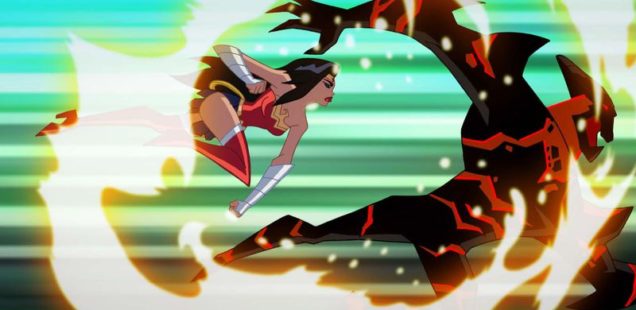
Justice League Action Does Right By DC Superheroes
A.V. Club: “Justice League Action” does right by DC superheroes with a joyful premiere
With DC superheroes getting significant attention in movies and television right now, it’s the perfect time to launch a new Justice League cartoon spotlighting the sprawl of the DC Universe. Justice League Action delivers on the promise of its title in its four-part premiere, “Shazam Slam,” with the driving force of the series being superhero fists flying through the air to pummel bad guys. This premiere is light on character development, but it still works well as an introduction to this new iteration of the Justice League, acquainting viewers with characters in an action-packed story that gains extra momentum from its consistent sense of humor.
Justice League Action plays like a combination of Warner Bros.’ two major superhero-team cartoons from the ’00s: Justice League/Justice League Unlimited and Teen Titans. The range of characters and the general tone are reminiscent of JLU’s lighter episodes (no Bush-era political allegories here), but with Teen Titans’ comedic sensibility and rounded, anime-influenced visual style. Justice League Action is intended for a younger audience, but the childish elements make the show refreshing when so many of Warner Bros.’ other DC projects try to appeal to adults by giving the characters and their worlds dour makeovers. This cartoon is the bright, cheerful alternative to Warner Bros.’ gray and joyless superhero films, and the freedom to be silly and as fantastic as possible opens up a wider range of stories for the creative team to tell.
“Shazam Slam” begins by taking DC’s most prominent street-level character, Batman (Kevin Conroy, continuing his 24-year run as the definitive voice of the Dark Knight), and throwing him into a mystical plot involving The Wizard (Carl Reiner) trying to make his way back to the Rock Of Eternity after being exiled by the evil Black Adam (Gary Cole). When the malevolent forces trapped within the Rock Of Eternity are set free, the Justice League unites to stop the demonic threats, with each part of this premiere featuring a new assortment of heroes taking down a different opponent.
This series centers on the core DC trinity of Batman, Superman (Jason J. Lewis), and Wonder Woman (Rachel Kimsey), but the premiere quickly expands to include a variety of both familiar and unexpected faces like Green Arrow (Chris Diamantopoulos), Cyborg (Khary Payton), Martian Manhunter (Crispin Freeman), Shazam (Sean Astin), Plastic Man (Dana Snyder), and Booster Gold (Diedrich Bader). Swamp Thing (Mark Hamill) and John Constantine (Damian O’Hare) are the most surprising additions, given their histories as two of DC’s most provocative characters, but the show has no problem making them fit into an all-ages story. Constantine is particularly delightful, having been hit by an accent-exaggerating spell a week prior that forces him to speak in a nearly incomprehensible English dialect.
Wes Gleason’s voice casting is exceptional, especially for the supporting cast. Reiner is the perfect actor to voice an immortal curmudgeon like The Wizard, and Astin’s youthful vocal quality makes him a great fit for Shazam, the adult superhero who the child Billy Batson transforms into. Bringing Payton over from Teen Titans Go! to continue voicing Cyborg ensures that the character maintains his vibrant personality (introducing him with his signature “Booyah!” is a nice touch), and Bader’s Booster Gold hits the exact balance of self-centered, oblivious, and pathetic that makes him one of DC’s most reliable comedic characters. As one of the most cartoonish superheroes in DC’s stable, Plastic Man demands a voice that is fully committed to the wackiness of the character, and Snyder doesn’t hold back with his intensely nasal, exaggerated voice work.
Given the range of characters in this episode, it’s not too much to ask for more women and people of color in the cast, because with the exception of Wonder Woman and Cyborg, every other major character in this episode is a white man. (Yes, Swamp Thing is technically a green elemental being, but he was a white man before he transformed.) There are many characters in the DC Universe who could help this show improve representation, and the writers should embrace that diversity so that the new generation of superhero fans has a broader idea of who can be a superhero.
The show’s animation is smooth and dynamic, and the team behind it has a clear understanding that the action is the top priority. Wonder Woman’s fight with the fiery Calythos (David Lodge) is a standout fight sequence, as is Shazam’s final showdown with Black Adam. Both scenes capture the immense power of the combatants, with storyboarding that shows the lead-up and follow-through of the moves in single shots rather than cutting to a new angle at the moment of impact, the go-to editing technique for superhero fights in live action. The detail and texture in the backgrounds significantly enrich the visuals, and these distinct environments draw the viewer deeper into the world of the series.
Future episodes of Justice League Action will be 10 minutes long, and the individual parts of this premiere tell separate stories that will function well as single chapters in reruns. There’s a larger narrative connecting them, and hopefully later installments will hold onto that element of light serialization, which gives this premiere a strong sense of direction. The show’s creative team has found a winning formula with the mix of action, comedy, and an expansive cast of characters, and there’s plenty in “Shazam Slam” to keep superhero fans of all ages coming back for more.


Recent Comments